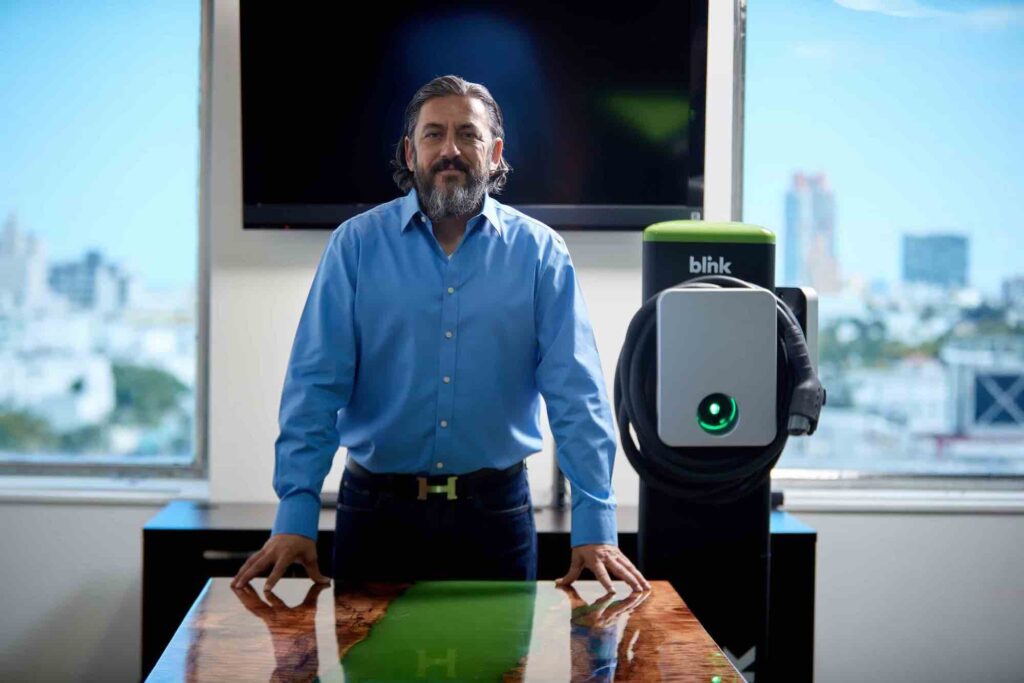Expanding abroad through partnerships, purchases
By Doreen Hemlock
Blink Charging shines as one of the world’s leading electric vehicle charging companies, with operations in 19 countries and plans to build a 500-worker factory and expand further internationally. But ask CEO Michael Farkas why he started the venture in Miami Beach more than a decade ago, and he won’t talk about environmentalism. Instead, he humbly tells a story of prayer.

A long-time financier, Farkas was going through a tough time in 2009: financial markets were volatile, a business deal had collapsed, and he was in the middle of a divorce. Farkas was getting ready to lay off two of his final employees but shuddered at the thought. Before entering the office in his garage, he prayed in full surrender.
“I asked God for a new direction,” says Farkas. “Then, I walked into my office, sat down, and it just so happened that on my desk were a couple of car magazines. I started reading them and read about the electrification of the automobile program.” Farkas realized that governments were investing millions of dollars in vehicles and batteries, but not a cent in fueling them. He sensed “an amazing opportunity.”
Within a few hours of researching, he had a new direction: to enter the EV-charging business. The answer to his prayer had come remarkably fast, says a humbled Farkas.
Dismissed at first; now, an admired pioneer
Back then, many people thought Farkas was crazy to pursue EV charging. For starters, he didn’t even have an EV-charging unit to offer. He began working with a team to develop one, but stopped when Toyota launched a prototype, figuring he’d be swamped by the Japanese car giant. When Toyota never followed through on production, he then teamed with a California group designing their first charger.
Soon, he started signing contracts with cities and other locales to install and operate EV-charging units. By 2018, the year Blink’s stock began trading on the Nasdaq exchange, he began to expand globally. In June of that year, he signed a deal with Israel’s Yacobi Brothers, a leader in smart-city construction. It agreed to integrate Blink technology into light poles with “flexible charging” for smart-city infrastructure.
The following year, Blink entered Europe through a joint venture with Athens-based Eunice Energy to deploy EV charging stations in Greece. In May 2021, it bought EV operator Blue Corner NV of Antwerp, Belgium, expanding its footprint on the continent.
Today, Blink has deployed more than 51,000 charging ports worldwide from the U.S. and Europe to Asia and Latin America. It just opened two offices in India to serve as operations hubs for the Middle East and Asia-Pacific regions, Farkas says. It is also vertically integrated: researching, designing, manufacturing, and selling EV charging units in parking garages, hotels, schools, and other public locations. It operates chargers for others as well. “There’s nobody I know of that’s an owner-operator on a global level like we are,” says Farkas.
Since it began reporting its financials as a Nasdaq-listed company, revenue has soared, nearly doubling to $11.5 million in the second quarter this year from a year earlier. But profits remain elusive for now, because Farkas is investing in the purchase of other companies to ensure long-term growth.

In April, Blink spent roughly $23 million to purchase Electric Blue in the United Kingdom, adding more than 1,000 charging units to its European network. And in June, it bought Maryland-based charging-unit producer and operator SemaConnect for about $200 million, adding 13,000 charging units to its U.S. network, and most importantly, bringing production in-house to ensure supply in the future.
The acquisitions have boosted Blink’s employee count to some 520 people, with about 40 working at its Lincoln Road headquarters on Miami Beach, says Farkas.
China at the forefront of electric vehicles
What’s stoking Blink’s business is a sudden boom in electric vehicle sales. In 2012, just 120,000 hybrid and plug-in EVs were sold worldwide. Last year, that same number sold every week. Indeed, the total number of EVs sold last year doubled from the previous year to reach 6.6 million, says the International Energy Agency, an inter-governmental group based in Paris.
The U.S. lags in those sales. China accounted for half the EVs sold last year: 3.3 million. The U.S. sold 630,000, double the number of a year earlier, but still a minimal portion of the global market. By comparison, in mid-2022, EVs accounted for 31 percent of new vehicle sales in China, versus five percent in the U.S., notes Farkas.
EV sales are soaring worldwide partly because of support from governments looking to cut carbon emissions. Government subsidies and incentives for EVs nearly doubled last year to $30 billion worldwide, says the IEA.
The bottleneck to EV growth is Blink’s sweet spot: not enough charging stations. “Current momentum in EV sales can only be sustained if ever larger shares of the population have access to convenient and affordable charging infrastructure, both publicly available and private chargers at residences and workplaces,” says the IEA.

Demand for charging units is staggering. Last year, the world added some 500,000 public EV chargers, three times the total installed capacity in 2017, says IEA. Farkas sees so much potential in Europe and beyond that he sees Blink becoming bigger overseas than in the U.S. Already, Blink’s app handles multiple languages and currencies to ease payments for drivers, some of who cross borders.
Still, China is not in Blink’s immediate growth plans. “If we could have the right partnership and right relationship, we’d enter that marketplace,” says Farkas. “You really need to have local partners there.”
A Blink factory in Florida?
Within the U.S., the EV industry is getting a big boost from new legislation that provides extra incentives, including tax-breaks on EV purchases. Farkas is keen to build a 500-worker factory to make more charging units. He’s mulling sites in Florida, Texas, Tennessee, and South Carolina.
“I’d love to put the factory in Florida, if it can be competitive,” said the 31-year resident of Miami Beach.
When he prayed for a new direction in 2009, Farkas never imagined the EV market would be as broad as it is today, with drones, trucks, trains, boats, and even planes going electric. “The future of transportation is using electricity,” he says.












